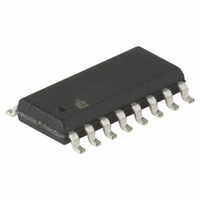ISL6721ABZ Intersil, ISL6721ABZ Datasheet - Page 12

ISL6721ABZ
Manufacturer Part Number
ISL6721ABZ
Description
IC CTRLR PWM SGL ENDED 16-SOIC
Manufacturer
Intersil
Datasheet
1.ISL6721ABZ.pdf
(22 pages)
Specifications of ISL6721ABZ
Pwm Type
Current Mode
Number Of Outputs
1
Frequency - Max
1MHz
Duty Cycle
100%
Voltage - Supply
9 V ~ 18 V
Buck
Yes
Boost
Yes
Flyback
Yes
Inverting
No
Doubler
No
Divider
No
Cuk
No
Isolated
Yes
Operating Temperature
-40°C ~ 105°C
Package / Case
16-SOIC (3.9mm Width)
Frequency-max
1MHz
Peak Reflow Compatible (260 C)
Yes
Rohs Compliant
Yes
Lead Free Status / RoHS Status
Lead free / RoHS Compliant
Available stocks
Company
Part Number
Manufacturer
Quantity
Price
Company:
Part Number:
ISL6721ABZ
Manufacturer:
Intersil
Quantity:
135
Company:
Part Number:
ISL6721ABZ
Manufacturer:
Intersil
Quantity:
500
Part Number:
ISL6721ABZ
Manufacturer:
INTERSIL
Quantity:
20 000
Part Number:
ISL6721ABZ-T
Manufacturer:
INTERSIL
Quantity:
20 000
Ground Plane Requirements
Careful layout is essential for satisfactory operation of the
device. A good ground plane must be employed. A unique
section of the ground plane must be designated for high di/dt
currents associated with the output stage. Power ground
(PGND) can be separated from the logic ground (LGND) and
connected at a single point. V
to PGND with good high frequency capacitors. The return
connection for input power and the bulk input capacitor
should be connected to the PGND ground plane.
Reference Design
The Typical Application Schematic on page 3 features the
ISL6721 in a conventional dual output 10W discontinuous
mode flyback DC/DC converter. The ISL6721EVAL1
demonstration unit implements this design and is available
for evaluation.
The input voltage range is from 36VDC to 75VDC, and the
two outputs are 3.3V @ 2.5A and 1.8V @ 1.0A. Cross
regulation is achieved using the weighted sum of the two
outputs.
Circuit Element Descriptions
The converter design may be broken down into the following
functional blocks:
Input Storage and Filtering Capacitance: C
Isolation Transformer: T1
Primary voltage Clamp: C
Start Bias Regulator: R
Operating Bias and Regulator: R
Main MOSFET Power Switch: Q
Current Sense Network: R
Feedback Network:, R
R
Control Circuit:C
R
Output Rectification and Filtering: C
C
Secondary Snubber: R
Design Criteria
The following design requirements were selected:
Switching Frequency, f
V
V
V
V
26
10
20
IN
OUT(1)
OUT(2)
OUT(BIAS)
: 36V to 75V
, R
, R
, C
27
11
21
: 3.3V @ 2.5A
: 1.8V @ 1.0A
, R
, C
, C
12
: 12V @ 50mA
13
22
, R
, C
7
14
14
, C
, R
, U
8
, C
22
2
13
sw
21
1
, U
, R
, R
9
, C
: 200kHz
R6
, C
4
3
2
, R
15
17
, R
, R
10
12
C
, R
3
, C
6
24
, R
should be bypassed directly
, Q
1
25
16
, C
11
23
, Q
, R
3
R4
, C
18
, V
, C
17
2
, C
12
R1
, D
4
, R
, R
R5
1
1
18
, C
, C
, C
5
, R
, R
5
2
15
, C
, C
6
19
, C
, R
R2
, R
3
16
8
, D
, R
20
, C
2
,
9
19
,
,
ISL6721
P
Efficiency: 70%
Maximum Duty Cycle, D
Transformer Design
The design of a flyback transformer is a non-trivial affair. It is
an iterative process which requires a great deal of
experience to achieve the desired result. It is a process of
many compromises, and even experienced designers will
produce different designs when presented with identical
requirements. The iterative design process is not presented
here for clarity.
The abbreviated design process follows:
• Select a core geometry suitable for the application.
• Select suitable core material(s).
• Select maximum flux density desired for operation.
• Select core size. Core size will be dictated by the
• Determine maximum desired flux density. Depending on
• Determine the number of primary turns.
• Determine the turns ratio.
• Select the wire gauge for each winding.
• Determine winding order and insulation requirements.
• Verify the design.
Input Power:
P
Max On Time: t
Average Input Current: I
Peak Primary Current:
I
PPK
OUT
OUT
Constraints of height, footprint, mounting preference, and
operating environment will affect the choice.
capability of the core structure to store the required
energy, the number of turns that have to be wound, and
the wire gauge needed. Often the window area (the space
used for the windings) and power loss determine the final
core size. For flyback transformers, the ability to store
energy is the critical factor in determining the core size.
The cross sectional area of the core and the length of the
air gap in the magnetic path determine the energy storage
capability.
the frequency of operation, the core material selected, and
the operating environment, the allowed flux density must
be determined. The decision of what flux density to allow
is often difficult to determine initially. Usually the highest
flux density that produces an acceptable design is used,
but often the winding geometry dictates a larger core than
is required based on flux density and energy storage
calculations.
: 10W
=
/Efficiency = 14.3W (use 15W)
---------------------------------------- -
f
sw
2 I
•
•
t
AVG IN
ON MAX
ON(MAX)
(
(
)
)
=
AVG(IN)
MAX
= D
1.87
MAX
: 0.45
= P
/f
A
sw
IN
= 2.25µs
/V
IN(MIN)
= 0.42A
March 5, 2008
FN9110.6
(EQ. 9)












